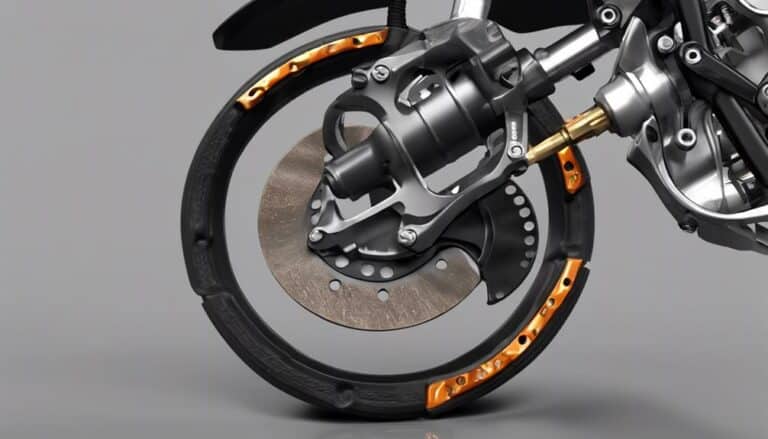Inspect the brake pads for thickness using a caliper, making sure they meet the 1.5-2mm requirement. Check for wear grooves and even wear. Monitor brake fluid level for hydraulic function and top up as needed. Examine brake lines for wear, replacing damaged ones promptly. Evaluate rotors for scoring and quality. Verify piston movement within the caliper and watch for sticking. Test brake lever and pedal response, adjusting tension if necessary. Finally, ensure smooth operation on a safe surface. Essential checks for top-notch dirt bike brake performance are critical for safe rides and efficient stopping power.
Key Takeaways
- Measure brake pad thickness with a caliper.
- Inspect for wear grooves on brake pads.
- Check brake fluid level for hydraulic function.
- Evaluate brake line condition for wear.
- Verify caliper functionality for even wear.
Brake Pad Wear Assessment
To evaluate the wear of your dirt bike brake pads, measure the thickness using a caliper to confirm it meets the critical 1.5-2mm minimum requirement for safe operation. Adequate pad thickness is vital for top braking performance and rider safety.
During visual inspections, look for wear grooves on Bendix Moto brake pads as indicators for easy assessment of pad material. It's essential to check for even wear across the brake pads to guarantee consistent braking efficiency.
Should thinning or uneven wear patterns be detected upon inspection, consider prompt replacement of the brake pads. Regularly monitoring and replacing brake pads is paramount in maintaining the dirt bike's braking performance and safety standards.
Brake Fluid Level Check
Consistently checking the brake fluid level is important to ensure excellent brake performance and safety on your dirt bike. Ensuring the correct brake fluid level is maintained is necessary for the hydraulic function within the brake system. Low brake fluid levels can compromise braking efficiency, leading to safety risks. It is essential to use the brake fluid grade recommended in your dirt bike's owner's manual to optimize performance. Inspecting the brake fluid level is a simple yet crucial step in maintaining your dirt bike's braking system. The table below outlines the importance of monitoring brake fluid levels:
| Brake Fluid Level Check |
|---|
| Important for performance |
| Necessary for safety |
| Maintains hydraulic function |
| Follow owner's manual recommendations |
| Simple yet essential maintenance step |
Brake Line and Rotor Evaluation
Examining the quality of brake lines and rotors is essential for maintaining excellent durability and performance in your dirt bike's braking system.
When inspecting brake lines, make sure they're of braided quality, correctly routed, and free from signs of wear or damage. Damaged brake lines can lead to brake system issues, so promptly replace any compromised lines.
For rotors, check for scoring, even wear, and quality to uphold efficient brake pad performance and overall braking effectiveness. Look out for bluing on rotors, indicating excessive heat. Opt for OEM or high-quality rotors to guarantee reliable braking performance, avoiding cheaper alternatives.
Verify mileage claims based on rotor condition, and refrain from using rotors with cracks or excessive wear to ensure safe and effective braking on your dirt bike.
Caliper Functionality Verification
Ensure proper functionality of your dirt bike's calipers by thorough inspection of brake pads and pistons. When evaluating caliper functionality, it is essential to check for even wear on the brake pads to guarantee consistent braking performance. Additionally, examine the remaining thickness of the brake pads as this directly impacts braking efficiency. Verify that the pistons are moving smoothly within the caliper to maintain peak brake operation. Look out for any signs of sticking or seizing pistons, as these issues can greatly impact your braking efficiency and overall safety.
To assist you further in understanding caliper functionality verification, refer to the table below:
| Caliper Functionality Check | Importance |
|---|---|
| Even Wear on Brake Pads | Ensures consistent braking |
| Remaining Thickness of Pads | Critical for braking performance |
| Smooth Pistons Movement | Maintains top-notch brake function |
| Sticking or Seizing Pistons | Affects braking efficiency |
| Professional Servicing | Recommended for irregularities |
Brake System Testing and Adjustment
To guarantee peak brake performance on your dirt bike, begin the Brake System Testing and Adjustment process by evaluating the brake lever and pedal response. Check for proper resistance to pressure. Fine-tune brake cable tension to ensure peak braking performance.
Inspect brake pads for wear, replacing them if below the recommended thickness to maintain braking efficiency. Verify brake fluid levels in the reservoir, topping up if necessary to prevent brake failure. Perform a test on a safe surface to confirm smooth and effective operation before riding, ensuring your safety.
Conclusion
To sum up, when evaluating your dirt bike brakes, make sure to examine key components such as:
- Brake pad wear
- Fluid levels
- Brake lines and rotors
- Caliper functionality
- Overall system testing
Are your brakes operating at their peak to guarantee your safety on the trails?
Remember, regular inspections and maintenance are essential for peak performance and rider safety. Don't underestimate the significance of keeping your brakes in top condition for your next ride.

